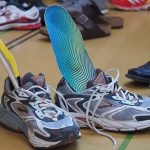Our feet are amazing; they are a masterpiece of natural engineering and we rely upon them to help us stay fit, mobile and well. Our feet take the weight of our whole body, so foot problems can quickly lead to discomfort and affect the way we walk, which can cause knee, hip and back pain.
If you’re over 60, foot care becomes even more important. As we age, our skin thins, joints begin to stiffen, it can become physically difficult to reach our feet, and failing eyesight doesn’t help. Those who suffer from diabetes are also at an increased risk of developing foot problems as raised blood sugar levels and circulation issues can damage the sensation in the feet. The NHS Choices website advice is that those who find caring for their own feet physically demanding should see a professional every six months for a foot “MOT”.
The College of Podiatry is urging people to discover how simple it is to keep their feet healthy and sound with these top tips:
Wear shoes that fit
You’d be surprised how many people don’t wear shoes that fit. Always try shoes on before buying them and as our feet swell throughout the day, buy shoes in the afternoon. Have your feet measured if possible.
Check your feet
Inspect your feet regularly to check for any changes or noticeable issues. Common symptoms to look out for are yellow, brittle and discoloured nails which can be a sign of a nail infection; flaky skin which could be dry or red and which can be a symptom of athlete’s foot and any changes to the structure of the foot such as swelling where the big toe meets the main part of the foot, as this can be a sign that a bunion is developing.
Wash and moisturise your feet
Make sure you give your feet a good wash at least once a day. Dry feet thoroughly, particularly between the toes, and apply a good foot moisturiser all over the foot except between the toes, which should be kept dry. The best foot creams contain urea.
Cut nails correctly
It’s best to use nail nippers, rather than nail cutters, because they have a smaller cutting blade and a longer handle. Cut your nails straight across and don’t cut too low at the edge or down the side. The corner of the nail should be visible above the skin. It is better to cut your nails after a bath or shower when they are much softer.
Wear the right shoes
For an everyday shoe you should ideally have some type of fastening to hold the foot in place so it doesn’t slip around. The shoe should comfortably accommodate the width of the foot and not be excessively narrow or tapered around the toes. The heel height should be relatively low (no higher than 2cm) but avoid completely flat shoes with very thin soles as these offer no shock absorption or support for the foot.
Don’t assume flat is best
Completely flat shoes with flimsy soles, such as ballet pump style shoes, are not great for frequent wear because they are so flat they offer very little shock absorption or support. Because they are slip-on they don’t hold the foot in place either, which causes the toes to claw to hold the foot in place.
Alternate shoes
When we wear shoes our feet naturally sweat and wearing the same pair every day doesn’t give the shoe a chance to dry out. A damp shoe can become a breeding ground for bacteria, which can cause bad odours and increase your risk of developing athlete’s foot.
Clean the inside of your shoes
To help keep your shoes clean and prevent them from becoming smelly, wipe the inside of your shoes with some surgical spirit on a cotton wool pad. This will help kill off any bacteria.
Don’t ignore foot pain!
If you experience frequent and on-going foot pain it is an indication that something isn’t right. It may be an underlying structural issue with your foot or it could be that the type of shoes you are wearing are not suitable for the activity. Don’t put up with pain; something can always be done and a podiatrist can work with you to diagnose the cause and help treat it.
If you are in any doubt about your foot health, you should make an appointment to see your GP or podiatrist. To find a podiatrist near you, please visit: www.nhs.uk/Service-Search/Podiatrists-and-chiropodists/LocationSearch/343 or speak to your local doctors’ surgery or health centre.
The College of Podiatry is the academic authority for podiatry in the UK, and an independent charity dedicated to foot health research, education and public awareness. Podiatry is the field of medicine that specialises in diagnosing and treating diseases and disorders of the foot and lower limb.





